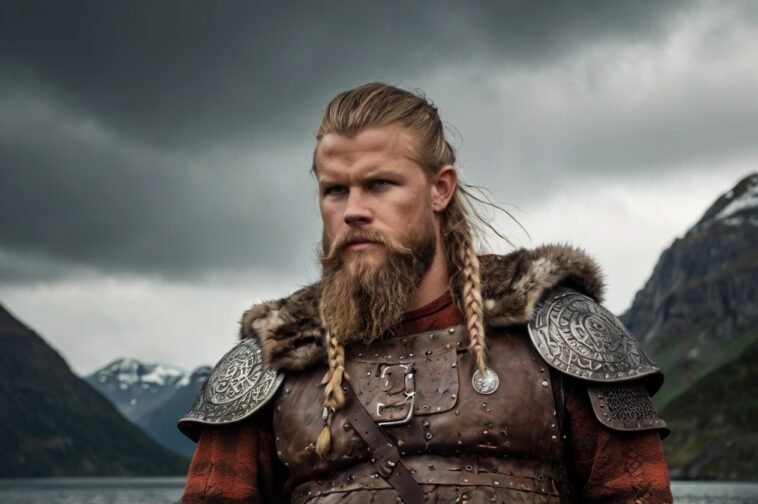
The Viking Age, spanning roughly from the late 8th century to the early 11th century, was a time of exploration, conquest, and cultural exchange.
Vikings, seafaring Norse people from Scandinavia, are often portrayed as ruthless raiders, leaving a trail of destruction across Europe.
But was this era solely about plunder and pillage, or did it reflect a deeper clash of civilizations?
By examining their motives, tactics, and the cultural interactions that followed, we can better understand the complex legacy of the Viking invasions.
Timeline of the Viking Age
The Viking Age was a remarkable period in history, spanning from 793 AD to 1066 AD.
It was a time of exploration, conquest, and cultural exchange that left a lasting impact on Europe and beyond.
Here’s a look at the key milestones of this era:
793 AD: The raid on Lindisfarne
The Viking Age is often said to have begun with the shocking raid on the Lindisfarne Monastery in England.
This attack wasn’t just violent—it sent shockwaves through Europe, marking the start of a period where Viking warriors became both feared and infamous.
865 AD: The great Heathen army
In 865 AD, a massive Viking force known as the “Great Heathen Army” landed in England.
This wasn’t just a quick raid—it led to years of conflict, settlement, and significant changes in English history.
The Vikings didn’t just plunder; they began to establish themselves in the lands they raided.
911 AD: The founding of Normandy
In 911 AD, Viking leader Rollo made history by signing a treaty with the Frankish king, Charles the Simple.
As part of the deal, Rollo and his followers were granted land, which became known as Normandy.
This marked a shift from raiding to settling and integrating into European society.
1066 AD: The battle of Stamford Bridge
The Viking Age is traditionally seen as ending in 1066 AD with the Battle of Stamford Bridge in England.
Here, King Harold Godwinson defeated the forces of Harald Hardrada, a Viking king.
This battle symbolized the decline of Viking power and the close of an extraordinary era.

Viking Raids
Motives
Economic gain
For many Vikings, the lure of wealth was the main reason for their raids.
Monasteries were prime targets because they were filled with valuable treasures like gold and silver—and they were often poorly defended.
But it wasn’t just about plunder.
Vikings also captured people during their raids, selling them as slaves in bustling markets across Europe and beyond.
Land acquisition
Life in Scandinavia wasn’t easy.
The harsh climate and limited farmland made it challenging to support growing populations.
This drove many Vikings to seek new lands where they could settle and thrive.
Over time, they established communities in places like Ireland, England, and even as far away as Greenland.
Political and social ambitions
For Viking leaders, raiding was more than just a way to gain wealth—it was a path to power.
Successful raids brought riches, which helped leaders attract followers and strengthen their influence.
A Viking who returned home with loot and glory often earned a higher standing in their community, solidifying their role as a leader.
Religious beliefs
Some scholars believe that Viking raids were also influenced by their Norse mythology.
Their stories and beliefs celebrated acts of bravery and conquest, and warriors who fought valiantly were promised a place in Valhalla—a grand hall where they could feast for eternity.
This belief in an honorable afterlife may have inspired Vikings to take bold and fearless actions.
Tactics
Superior seafaring skills
The Vikings’ longships were a game-changer.
These sleek and versatile vessels were fast, easy to maneuver, and capable of traveling both the open ocean and shallow rivers.
This gave the Vikings incredible reach, allowing them to raid inland settlements that other seafarers couldn’t dream of reaching.
Their mastery of the seas was unmatched, and it gave them a huge tactical advantage.
Surprise attacks and hit-and-run tactics
Speed and surprise were key to Viking success.
They would strike suddenly, often before their targets had any chance to prepare.
These swift, unpredictable raids spread fear far and wide, leaving little time for resistance.
And once they had taken what they came for, the Vikings were gone just as quickly as they had appeared.
Targeting monasteries and wealthy settlements
The Vikings knew where to hit to maximize their gains.
Monasteries, for example, were full of treasures like gold and silver but were often poorly defended.
Wealthy settlements with minimal protection were also prime targets.
By choosing their raids wisely, the Vikings were able to plunder significant riches with minimal risk.
Impact
Fear and devastation
Viking raids were terrifying.
Imagine seeing swift ships appear out of nowhere, bringing fierce warriors who showed no mercy.
Historical records from that time describe the Vikings as an unstoppable force of destruction, leaving towns and monasteries in ruins.
Their reputation alone often caused widespread panic.
Fortification of towns and monasteries
The constant threat of Viking attacks forced towns and monasteries to rethink their defenses.
Walls were built taller and stronger, and settlements became more secure.
This push for protection played a big role in the development of advanced fortifications and military architecture that defined the medieval period.
Development of new military technologies
Defending against the Vikings wasn’t easy, and it pushed European communities to innovate.
New weapons, better armor, and even improvements in naval technology were developed in response to Viking invasions.
These advancements had a long-term impact, shaping military strategies for centuries to come.

Beyond Raids: Cultural Exchange and Interaction
Trade and commerce
While Vikings are often remembered for their raids, they were also skilled traders.
Viking trade routes connected Scandinavia with the Mediterranean, the Middle East, and even Central Asia.
Goods such as amber, furs, and weapons were exchanged for silver, spices, and textiles.
This exchange also facilitated the spread of ideas and technologies, such as advanced shipbuilding and metalworking techniques.
Settlement and integration
Viking settlements
Vikings established permanent settlements in various parts of Europe, including Normandy (France), Dublin (Ireland), and the Danelaw region (England).
These settlements often became thriving hubs of cultural exchange.
Intermarriage and cultural blending
Intermarriage between Vikings and local populations led to a blending of traditions, languages, and customs.
Adoption of Christianity
Over time, many Vikings converted to Christianity, influenced by the regions they settled in and traded with.
This marked a significant shift in their cultural and religious identity.
Cultural influence
Impact on art, literature, and language
Viking art, characterized by intricate designs and motifs, influenced European decorative styles.
Norse mythology and sagas also left a lasting imprint on European folklore.
Legacy of Norse legends
Tales of Viking gods and heroes inspired countless literary works, from medieval epics to modern fantasy novels.

Clash of Civilizations
Different worldviews
Paganism vs. Christianity
The Vikings’ pagan beliefs, which emphasized bravery, fate, and a pantheon of gods, often clashed with the monotheistic, salvation-focused worldview of Christian Europe.
Conflicting social structures
Viking societies valued individual prowess and decentralized power, contrasting with the hierarchical structures of feudal Europe.
Power dynamics
Competition for resources and territory
Viking expansion often brought them into conflict with established European powers, leading to prolonged struggles for dominance.
Political and religious dominance
The integration of Viking settlers into Christian Europe often involved negotiations of power, leading to treaties, alliances, and eventual assimilation.
Long-term consequences
Reshaping of European political landscape
The Viking Age led to the establishment of new political entities, such as the Duchy of Normandy, which played a significant role in European history.
Stimulation of innovation and defense mechanisms
The need to counter Viking invasions spurred advancements in military strategy, fortification, and governance.

Final Thoughts
The Viking Age was far more complex than mere raids and plunder.
It represented a dynamic period of conflict, exchange, and transformation.
While the Vikings’ initial incursions brought fear and destruction, their legacy includes significant contributions to trade, culture, and the reshaping of Europe.
Understanding the multifaceted nature of this era allows us to appreciate how it shaped the course of history.



